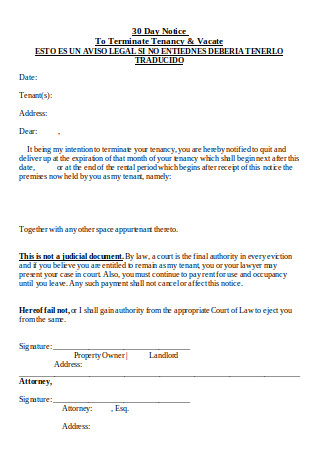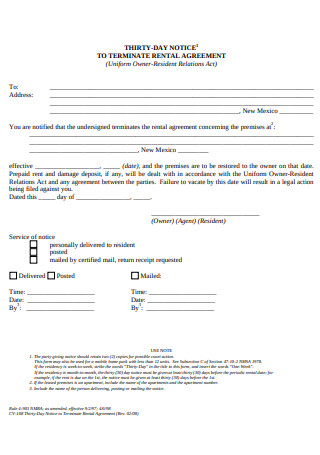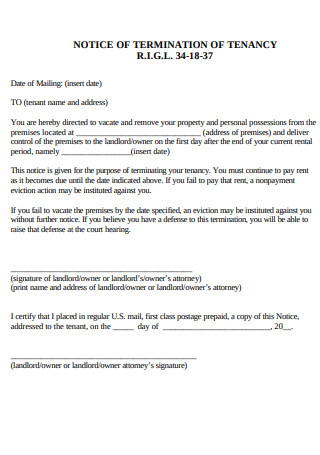20+ Sample 30-Day Eviction Notice Forms
-

Thirty Day Notice of Termination Form
download now -

Sample Form of Thirty Day Notice
download now -

30-Day Notice to Terminate
download now -

30 Day Notice to Evict Without Cause
download now -

30-Day Notice of Termination of Tenancy
download now -

Example of Notice of Termination of Tenancy
download now -

30 Day Notice Eviction Form
download now -

30 Day Notice to Vacate Form
download now -

Non Payment Notice of Rent
download now -

Eviction Notice Form
download now -

30 Day Non Payment Notice to Quit
download now -

30-Day Notice Lease Violation
download now -

30-60 Day Notice of Termination of Tenancy
download now -

Thirty-Day Notice to Terminate Rental Agreement
download now -

Notice to Vacate or Eviction Form
download now -

Thirty Notice to Intent to Vacate
download now -

30 Day Notice to Correct or Vacate
download now -

Notice to Leave Premises
download now -

Notice of Termination of Tenancy
download now -

Eviction Notice from Landlord
download now -

Notice to Terminate Month to Month Tenancy
download now

What Is a 30-Day Eviction Notice?
A 30-day eviction notice is a type of notice that may be written for a number of circumstances. It can be used to inform the tenant to leave the premises within 30 days from when the document was issued. The notice may also be intended to advise a change in tenancy terms that shall take effect in 30 days. The tenant may even write a 30-day notice to announce their plan to move out of the property in 30 days. As a landlord, you don’t need to state the exact reason for the termination, as long as you comply with state laws in terms of preparing and serving notice. If the tenant fails to vacate the property within the said period despite the landlord’s effort to provide notice beforehand, this can be used as the basis for a lawsuit and a court order to have the tenant leave. While the length of the required notice may vary from state to state, 30 days is a reasonable amount of time for a person to pack their belongings and vacate the premises.

When Can You Use a 30-Day Eviction Notice?
There must be a reason why you even considered using a 30-day eviction notice, whether or not you choose to disclose this information to a tenant. Not having a reason to evict a tenant will put you at risk of a lawsuit, especially if the tenant’s rights are favored by the rental agreement you had them sign. What constitutes a breach in the agreement would depend on the terms being agreed upon. A notice to quit, for instance, is served to a tenant for when the rent has not been paid. Unconditional quit notices are even provided to tenants who have caused damage to the property or been consistently late with their rental payments. Tenants who bring a pet to the property or allow a visitor to stay overnight have also broken the rental agreement and are subject to eviction. Fortunately, these circumstances can be corrected by the tenant through a settlement. So if you do receive a pay rent or quit notice from your landlord, it is possible to cancel the eviction by paying the required amount as soon as possible.
The Importance of a 30-Day Eviction Notice
No matter how frustrated you are about a nonpaying or problem tenant, you should never try to remove them from the premises without adequate notice. Proper legal action and paperwork are essential to ensure that your business fully operates within the laws of the state. Documenting whatever you communicate with tenants can also leave a paper trail that will work in your favor. The document may serve as evidence to prove that a notice was given to proceed with the termination. The eviction notice must indicate the tenant’s noncompliance with the lease terms, the date by which the tenant should settle the issues at hand, and a written warning that expresses your intentions to take further legal actions if the settlement is not met. The right paperwork and records will help ensure that the eviction process runs as smoothly as possible. An eviction form or letter may be utilized to follow the legal procedure of terminating a tenant, so don’t forget to sign the document to certify its legitimacy.
How to Make a 30-Day Eviction Notice
In 2017, the Community Service Society recorded 230,000 residential eviction petitions filed by landlords in New York City’s housing court, with another 21,000 evictions executed by City Marshalls. But in spite of these numbers, it’s never easy for a landlord to evict a tenant from their property. The decision to evict a tenant from the premises is not an easy one to make, but it’s sometimes necessary when there’s no other way to resolve a problem. As a landlord, it is your obligation to draft and deliver an eviction notice that complies with the laws within the state.
Step 1: Address the Notice to the Tenant
Refer to the name of the individual specified in the lease. It can be the name of the person, the partnership, or the corporation renting the area. Depending on the type of residential or commercial lease that was signed, the landlord may choose to evict one or all of the tenants listed in the agreement. The correct names of these tenants must be reflected in the notice to make it valid. Once this is done, a new lease may be created to include the tenants that want to continue renting the property for another term.
A standard eviction notice, whether it’s a 3-day or 30-day notice to evict, should contain detailed information about the rental property. This includes the full address of the house or building and the date when the lease was signed.
Step 2: Inform the Tenant of the Eviction
The first sentence of the notice must state what the document is for. In most cases, this is indicated in bold letters to emphasize the author’s intent and issue a fair warning to the recipient. The purpose of the notice should be written clearly and concisely to get your message across.
Step 3: State the Reason for the Eviction
If you’re giving a tenant the chance to resolve the situation in hopes of canceling the eviction process, then the notice must clearly state the terms that need to be met and the date by which it needs to be completed. There are many reasons why a landlord would want to evict a tenant. Conducting an illegal activity within the premises, failing to pay the rent on time, causing damage to the property, and being a nuisance to others even after being asked to stop are just some of the common reasons that force a landlord to evict a tenant.
Step 4: Specify the Date You Want the Tenant to Vacate the Property
For a 30-day month-to-month lease, the end of the current month and one full month beyond is generally provided for the tenant to move out. Quicker evictions are usually applicable only for tenants who have committed extreme violations that cannot be settled. After you determine the appropriate time frame, the specific date of eviction should be specified in the eviction notice.
Step 5: Secure a Personal Copy of the Notice
Even after presenting the eviction notice to the tenant, their compliance is never guaranteed. The case may be brought to court in order to settle the affair on legal grounds. When this happens, the notice can be used to prove that the required amount of time was provided and that your team had followed all the necessary measures to carry out the eviction.
Step 6: Serve the Eviction Notice to the Tenant
The final step of the process is to deliver the eviction notice to the tenant. The notice is typically put on the front entrance of the residence or sent directly to the tenant staying on the property. This depends on the area that the rental property is located in, as some circumstances require local law enforcement to do the posting on behalf of the property owner. Obtaining a court order is also necessary for some counties and states.

The Dos and Don’ts of a 30-Day Eviction Notice
Being a landlord is a tough job. Although the income stream guarantees long-term wealth, your efforts to build a good relationship with your tenant can sometimes backfire when you fail to draw the line in the relationship. Even the most careful landlords will have to go through the eviction process at least once in their career. Thus, there are some things you need to remember as you move forward with the eviction. To properly evict an occupant from the premises, it’s important to keep the following guidelines in mind:
What to Do
1. Do try to resolve the issue before going to court.
Everyone deserves to make up for their mistakes. By giving prior notice about the eviction, tenants have the chance to correct the problem before court filings begin. You’d be surprised by how most tenants are willing to take the appropriate measures just to avoid the legal consequences of their actions. It would be embarrassing to remove a tenant from the property after a simple misunderstanding that could have been addressed if you made the attempt to listen. If the basis of the eviction can still be settled, the 30-day eviction notice should give the tenant enough time to rectify their fault.
2. Do abide by the laws of the state.
There are different versions of the Landlord and Tenant Act across the U.S. Each rental policy is made specific for landlords around the state to adhere to. These laws also cover the specifics in landlord-tenant relationships to ensure that the rights and obligations of each party are protected. If you intend to kick a tenant out due to a minor inconvenience, you might want to rethink your decision before moving forward with the case. Most tenants would want to know the terms that they have violated through the notice being issued. It’s also best to create a rental lease agreement that conforms to local and state laws to avoid legal problems down the road.
3. Do think before you act.
Don’t attempt to do something you know you’ll end up regretting. The amount of stress that you’re forced to go through when dealing with a problem tenant does not give you permission to act petty. Forcibly removing a tenant from the property by shutting off all utilities and changing locks will only give the court a reason to act in the tenant’s favor. That’s because irrational decisions can never produce favorable results. Instead, look for other ways to handle your frustrations without putting your case in jeopardy.
4. Do be professional.
As a landlord, you want to show your tenants that you take your business seriously. A written notice of eviction will prove that you’re looking into the matter and refuse to let it slide so easily. Maintaining your composure when discussing the issue with a tenant is one way to avoid a heated argument and establish professionalism throughout the exchange. It’s better to tackle the problem which led you to terminate the tenancy rather than to throw away all your tenant’s belongings after a dispute.
5. Do stick to your policies.
Once you set some ground rules, there’s no way of revoking a directive unless a clause authorizes you to do so or if you take the right measures to update the lease beforehand. Some occupants tend to abuse the kindness of their landlords by asking for favors and exemptions after committing a violation. If your lease agreement prohibits unlawful activities within the premises, immediate action must be taken to terminate the tenancy. The landlord may choose to provide a 30-day notice of eviction to the tenant, or something of a shorter time frame to prevent further concerns.
What Not to Do
1. Don’t take it lightly.
If a tenant does something inexcusable, you need to handle the situation accordingly. Both minor and major violations should not be taken lightly; otherwise, the tenant is bound to take advantage of the situation and make things hard for you. But a legal proceeding should only be your last resort when it comes to bad tenants. It is possible to resolve the problem and still evict the tenant by giving proper notice. Taking the time to consider resolutions outside of the court’s jurisdiction will save you from the trouble of court filings and case hearings.
2. Don’t let your emotions get the best of you.
The amount of stress caused by a problem tenant can often take a toll on your physical and emotional wellbeing. It’s easy to lose your temper during arguments, especially when a tenant refuses to comply with your request. But getting overly emotional can often worsen the situation and place a property owner at a disadvantage. Even if it isn’t your intention to offend anyone, the things you say or write in your eviction notice may be construed as proof of housing discrimination. Hence, it’s always best to confront the ordeal with a sound mind.
3. Don’t intimidate or threaten a tenant.
If you think the easiest way to make a tenant leave is to harass them or make them feel uncomfortable in the home, you could be putting your housing business on the line. Other tenants in your property may condemn your actions and report the case to state officials. Instead of having the upper hand in the case, you could be digging a hole to bury your career forever. Even if the tenant refuses to obey your 30-day eviction notice, you must never take matters into your own hands. A proper eviction procedure must be followed to prevent your problems from growing any bigger.
4. Don’t neglect your responsibilities.
If you have a lease that outlines the rights and responsibilities of landlords and tenants, you need to make sure these terms have been obeyed since the start of the effective date. It’s important to uphold your end of the agreement even if tenants fail to adhere to theirs. For example, poor maintenance in the building has been a prevalent issue despite your promise to address any concerns that relate to it. If the other party points this out during a discussion, your violation could lessen the impact of the eviction notice on the problem tenant.
5. Don’t deal with it alone.
Not many landlords are knowledgeable of their local and state laws. If you believe you aren’t qualified to handle an eviction on your own, don’t hesitate to seek professional help. The last thing you would want to do is to issue an immediate eviction on a tenant who missed his first payment after three years of occupancy. There are also cases where tenants could easily manipulate the situation with the help of their personal attorney, so to avoid foul play, consulting an experienced lawyer is sure to offer you the legal assistance you need to survive the eviction process.
Like most legal documents, writing a 30-day eviction notice is always easier when you know exactly what goes into its content. If you haven’t had much experience with notices before, you can download a form template as a reference to create the document. An eviction notice template can be useful for effective property management, especially when you have several properties run at the same time.
